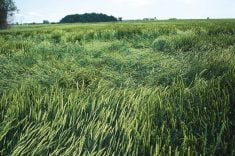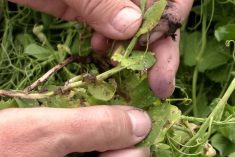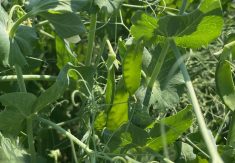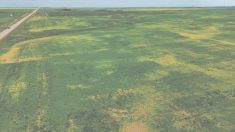
Andy has a 2,000-acre mixed farm operation near Vauxhall, Alta., where he raises cattle and grows wheat, canola, sugar beets, beans, field peas and hay. I had worked with Andy for some time and knew he’d stepped up his scouting efforts that summer, due to the fact the growing season had been unusually cool and wet compared to previous years.
In early August, Andy called me to say he didn’t like how his field pea crop was shaping up. He’d been alarmed to see patches of lodged plants scattered throughout the field. In addition to the lodging, the affected plants had smaller seeds in their pods than they should at this point in the season. It was also clear to Andy the crop staging wasn’t consistent in the field, with plants in those areas that were most affected up to a week closer to maturity.
Andy said he wasn’t sure what was causing the problem, but he thought it might be a seed quality issue. He asked me to come out to see if I could pinpoint exactly what was going on.
Once I arrived at Andy’s farm and looked out at the problem field, I could see the affected areas were spread randomly throughout the crop including on hilltops and in lower parts of the field, so topography didn’t appear to be a main factor in the equation.

I then did a thorough examination of some individual pea plants. Starting at the top, I could see the smaller seeds Andy had talked about, and as I moved further down the plant, I observed some leaves exhibiting minor ascochyta blight damage.
As I neared the bottom of the plant, I noticed there was some stem rot occurring which extended six inches or so up from the soil surface. I looked for white mould, but there was no trace of it either on the plants or the soil surface.
When I dug up a few affected plants, I could see there was very little root mass and almost no nodules were present on the roots — a stark contrast to the root systems I observed when I uprooted some healthier-looking plants for comparison purposes.

I began considering all the possible explanations for what I was seeing. I was aware Andy had planted good quality seed which had been tested for germination, so that wasn’t the issue. I also knew the seed had been treated with fungicide to protect against fusarium and it had also been inoculated to facilitate root nodule development for nitrogen fixation.
Excess nitrogen can cause lodging in field pea crops, but I thought that was unlikely in this case based on the low residual nitrogen in the soil tests and conservative nitrogen fertilization program we’d recommended.
What, then, was causing the symptoms in Andy’s ailing field pea crop?
Crop Advisor’s Solution: Root disease to blame for ailing field peas
Read Also

Claas brings 1000 Series SP forage harvesters to Canada
In mid-August, Claas unveiled its new line of Jaguar forage harvesters at an event in Visalia, California, deep in the heart of that state’s dairy region.
After examining some affected plants, I ruled out cutworms as a possible cause because the stems were intact, and it was too late in the season for cutworm damage. I also could see ascochyta blight damage on some leaves, but it was relatively minor. I was more concerned when I found signs of stem rot on the lower parts of the plants.
When I dug up some affected plants and had a look at the roots, the cause of the problem became much clearer. There was very little root mass and almost no nodules on the roots, making the plants very susceptible to lodging.
I knew Andy had planted inoculated seed, which should have promoted root nodule growth, so I thought the lack of nodules and also root mass was probably the result of disease. There was another important factor that pointed to root disease as well — the weather had been cool and wet, unlike the warm and dry conditions normally seen in Andy’s area during the growing season, resulting in higher disease pressure in the soil.
When I sent in some root samples for lab tests, the results confirmed the presence of not just one but three fungal pathogens — fusarium, phythium and rhizoctonia.
Unfortunately for Andy, there wasn’t anything he could do at that point to improve his crop. Andy decided to desiccate the field peas due to the variance in crop staging, and he ended up losing about half of what his average yields are.
Going forward, Andy now knows what to look for in his field peas if a similar situation arises in the future. He’s also aware he can take preventative action by ensuring a proper crop rotation, using a clean seed source, treating his seed with a multi-mode of action fungicide and keeping his crops free from disease with foliar applications in-season when required. These preventative actions will help reduce the disease pressure in the soil, which can flare up, especially when cool, wet conditions are present in the early spring.
Becky Howg, CCA, RTAg, works for Richardson Pioneer Ltd. in Vauxhall, Alta.















